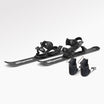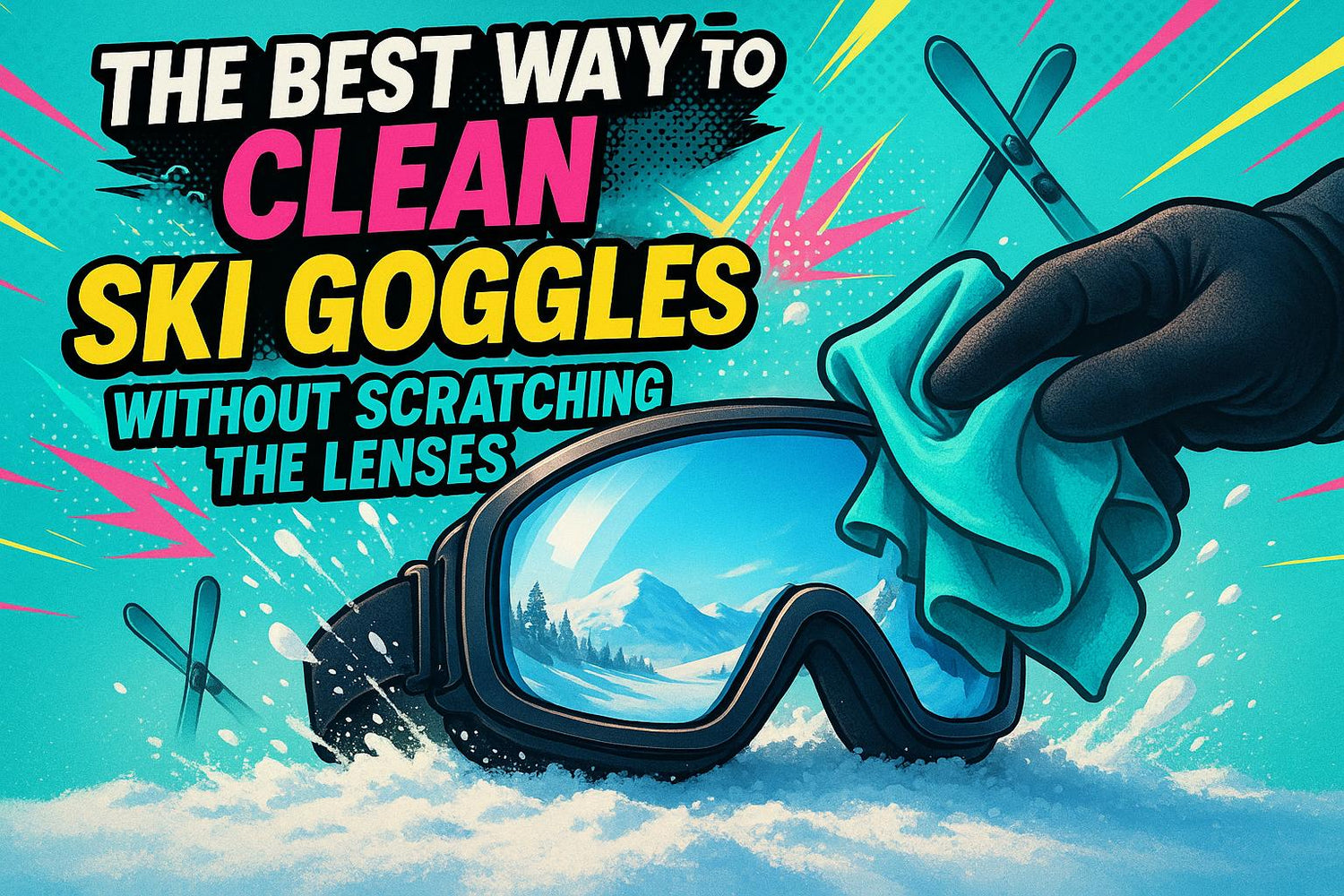Cleaning your ski goggles the right way isn't just about keeping them looking good - it’s about protecting your investment and ensuring a clear view on the slopes. Here’s the deal: improper cleaning can scratch your lenses, ruin the anti-fog coating, and mess with your visibility. But with the right tools and techniques, you can keep your goggles in top shape for years.
Key Takeaways:
- Use a microfiber cloth: It’s gentle on lenses and prevents scratches. Avoid paper towels, t-shirts, or gloves.
- Skip household cleaners: Only use goggle-specific solutions or plain water to clean your lenses.
- Be careful with the inner lens: It has a sensitive anti-fog coating. Never wipe it - dab gently if needed.
- Store goggles properly: Use a microfiber bag or hard case to prevent damage. Let them air-dry completely before storing.
Steps to Clean Goggles:
- Shake off loose debris or let ice melt naturally.
- Clean the outer lens with a microfiber cloth using small, circular motions.
- Handle the inner lens gently - dab, don’t wipe.
- Air-dry goggles in a ventilated space, away from direct sunlight or heat.
How to Clean Ski Goggles | Avoid scratches and store them right when not in use
Tools and Materials You Need for Cleaning Ski Goggles
Taking care of your ski goggles doesn’t require a ton of fancy gear, but using the right tools can make all the difference in keeping them scratch-free and in great shape. Whether you’re rocking classic brands like Atomic or trying out Snowfeet*’s creative designs, these tips and tools will help protect your goggles and keep them crystal clear.
Microfiber Cloths: Your Goggles' Best Friend
When it comes to cleaning goggle lenses, microfiber cloths are the gold standard. Why? The fibers in microfiber cloths are much finer than those in cotton or other materials. This allows them to grab and trap tiny particles that could otherwise scratch your lenses. Plus, they often work with just water, so you don’t need to use harsh chemicals.
Another bonus? Microfiber cloths are durable and reusable. You can use one hundreds of times, making it a cost-effective and eco-friendly choice. On the flip side, avoid paper towels, your jacket sleeve, or a neck tube - they can scratch your lenses and ruin the delicate coatings.
Pro tip: Keep a spare microfiber cloth in your jacket pocket while you’re on the slopes. It’s a lifesaver for quickly wiping away snow or condensation.
Once you’ve got your cloth ready, pair it with the right cleaning solution for the best results.
Goggle-Specific Cleaning Solutions
Steer clear of household cleaners - they might seem harmless, but they can strip away the anti-fog and reflective coatings on your goggles. Instead, stick to cleaning solutions that are specifically made for ski goggles. These are designed to gently remove dirt, oils, and grime while keeping those delicate coatings intact.
If you’re unsure, play it safe with additive-free water or a cleaning solution recommended by your goggle’s manufacturer. And whatever you do, avoid using harsh chemical sprays or solvents - they can permanently damage your goggles.
After cleaning, how you store your goggles is just as important as how you clean them.
Smart Storage for Long-Lasting Goggles
A proper storage solution can protect your goggles from scratches and environmental wear and tear. Many goggles come with a microfiber storage bag, which doubles as a cleaning cloth. These bags are great for keeping your lenses safe when you’re not wearing them. For even more protection, consider a hard case, especially if you’re traveling or packing your gear tightly.
Here’s a key tip: Always let your goggles air-dry completely before storing them. Moisture trapped in a bag can damage the foam or lenses over time. Once they’re dry, place them in a microfiber bag or case to avoid scratches and extend their lifespan. With good care, your goggle lenses can last 6–7 years - not a bad return for a little extra effort.
Whether you’re using trusted brands like Head or Atomic or experimenting with Snowfeet*’s innovative styles, these simple steps will ensure your goggles stay in top condition for seasons to come. Clear vision and long-lasting gear? Totally worth it.
Step-by-Step Guide to Cleaning Ski Goggles
Got your cleaning tools ready? Great! Let’s dive into the process of cleaning your ski goggles step by step. Whether you’re rocking classic brands like Rossignol or experimenting with Snowfeet*’s sleek designs, the trick is to take your time. Rushing can lead to scratches, and no one wants that. Here’s how to keep your goggles clear and scratch-free for the slopes.
Step 1: Remove Loose Debris
First things first - get rid of any loose snow, dirt, or ice on your goggles. Gently shake or tap them, but skip using your gloved hands. Even tiny particles on gloves can scratch the lens.
Got ice stuck on there? Resist the urge to scrape it off. Instead, tuck your goggles inside your jacket for a few minutes to let the ice melt naturally. For stubborn bits that won’t budge, grab your soft goggle case, flip it inside out, and lightly brush the lens. Once the debris is gone, you’re ready to clean the outer lens.
Step 2: Clean the Outer Lens
The outer lens tends to pick up dirt, fingerprints, and watermarks - especially if it has a mirrored finish. Start cleaning by using small, gentle circular motions, beginning at the center and working outward.
For tougher spots that don’t wipe away easily, spritz a bit of cleaning solution onto the lens. Let it sit for a few seconds to loosen the grime, then dab it away with a clean section of your cloth. This careful approach works whether you’re using goggles from Atomic or Snowfeet*.
Step 3: Handle the Inner Lens Carefully
The inner lens is coated with an anti-fog treatment, which makes it super sensitive. Avoid touching it unless absolutely necessary. If it’s wet, gently tap off any excess moisture and let it dry completely before cleaning.
"Never touch the inside of the lens! Especially when wet! Why? Because the inside lens is extremely delicate as it is treated to prevent the lens from fogging." - shredoptics.com
If you must clean the inner lens, wait until it’s completely dry. Then, lightly pat it with a tissue or a clean microfiber goggle bag - no wiping motions allowed. For deeper cleaning, you can disassemble the lens from the frame and let it air dry in a cool, dry spot.
Step 4: Dry and Store Properly
Once your goggles are clean, it’s time to dry and store them the right way. Let them air dry in a warm, ventilated area, but keep them out of direct sunlight or extreme temperatures. After they’re fully dry, store them in their original bag or a protective case to avoid scratches.
Make sure the face foam is dry too. Damp foam can lead to odors and wear out faster. Whether you’re packing away Rossignol goggles or Snowfeet*’s compact styles, proper storage keeps them in top shape for your next ride.
Taking a little extra time to care for your goggles goes a long way. Clear lenses mean better visibility, which makes your time on the slopes safer and a whole lot more fun.
sbb-itb-17ade95
How to Prevent Scratches and Make Your Goggles Last Longer
Taking care of your goggles doesn’t have to be complicated, but it’s essential if you want to keep them scratch-free and in good shape. Even with anti-scratch coatings, goggle lenses - made of plastic - are still prone to scratches. Whether you’re rocking Head, Elan, or Snowfeet* designs, these tips can help keep your goggles in top condition.
Proper Storage Practices
The way you store your goggles can make all the difference. Always use the microfiber bag or padded case that came with your goggles. That microfiber bag isn’t just a freebie - it’s your first line of defense against scratches. Make sure your goggles are completely dry before storing them to avoid moisture buildup, which can lead to mold, funky odors, and damage to the anti-fog coating. For added protection, you can even store your goggles inside your helmet when you’re not using them.
Avoid tossing your goggles loosely into your gear bag where they might get scratched by other equipment. If you’re traveling, wrap them in a soft shirt or jacket for extra padding. When it comes to long-term storage, keep them in a cool, dry spot like an indoor closet - not in a garage or basement where temperature and humidity can fluctuate. Even Snowfeet* goggles, known for their durability, benefit from these simple storage habits.
And don’t forget to protect your goggles from extreme temperatures.
Avoiding Temperature Extremes
Temperature extremes can wreak havoc on your goggles. Heat can warp the frame, distort the lenses, and even degrade the foam padding. Leaving your goggles in a hot car or directly on the snow for long periods can cause permanent damage.
Whenever possible, store your goggles at room temperature. Skip places like car dashboards, glove compartments, or unheated garages. Temperature swings can also lead to fogging, which reduces visibility and performance. If you’re staying at a ski lodge or cabin, bring your goggles indoors overnight to let them dry completely and avoid damage from fluctuating temperatures. Whether you’re using Atomic goggles or Snowfeet*’s sleek models, keeping them in stable conditions helps maintain their lens coatings and frame quality.
Finally, handling your goggles with care is just as important.
Handling Goggles with Clean Hands
Proper handling is the cherry on top of good goggle care. Always grab your goggles by the strap or frame - not the lens - to avoid fingerprints, smudges, and scratches. Make sure your hands or gloves are clean before touching them. Dirt or grit can act like sandpaper on your lenses. If your gloves are dirty or wet, clean them off first or use a soft microfiber cloth instead. Also, keep in mind that oils from your skin can harm the anti-fog coating on the inner lens.
Snowfeet* Goggles Care vs. Rossignol, Atomic, Elan, and Head Brands

Snowfeet* goggles are designed with simplicity in mind, making maintenance a breeze. While some brands don’t always provide detailed cleaning instructions, Snowfeet* takes a user-friendly approach that aligns with general best practices for keeping goggles in great shape.
Cleaning Snowfeet* goggles is as easy as it gets. A soft microfiber cloth is all you need to gently wipe away moisture and fingerprints, protecting the delicate coatings on the lenses. This straightforward routine ensures that your goggles stay in top condition without the hassle often associated with traditional brands. Let’s just say, Snowfeet* makes cleaning feel less like a chore and more like a quick pit stop.
One key to keeping your goggles performing well is preserving the anti-fog coating, which is essential for clear vision on the slopes. As Dan Sevaldson, Senior Hardware Designer for Sweet Protection, points out:
"The outside of lenses often have a protective coating to reduce the risk of scratches, but will still scratch if the mechanical impact is hard enough".
Even with protective coatings, scratches can happen under heavy impact, so gentle care is crucial.
Snowfeet* goggles make it easy for both beginners and seasoned skiers to maintain their gear. With these simple cleaning techniques, you can enjoy clear vision and reliable performance season after season.
Summary and Final Tips
Key Takeaways for Proper Goggle Care
Keeping your goggles scratch-free and in top condition isn’t rocket science - it just takes the right tools and a little care. First off, always use a microfiber cloth designed specifically for cleaning eyewear. It’s the best choice for keeping your lenses spotless without risking scratches.
Before you even think about wiping, rinse your goggles with lukewarm water to wash away any loose debris. For the inner lens, stick to gentle dabbing - never wipe it. The outer lens needs the same careful touch, as aggressive cleaning can damage its protective coating.
Temperature plays a role, too. Store your goggles in moderate conditions to protect those delicate lens coatings. Whether you’re rocking Snowfeet* goggles or brands like Rossignol or Atomic, these tips work for all models.
By following these steps, you’ll set yourself up for long-lasting, crystal-clear performance from your goggles.
Final Reminders for Longevity
Research from Burton shows that proper cleaning and storage can make a huge difference in how long your goggles last. With good care, your lenses can survive multiple seasons instead of needing a replacement every year.
"Proper cleaning and storage can significantly increase how many seasons you get out of a pair of goggle lenses. In fact, taking a few extra steps to regularly care for your lenses will allow you to carry them into multiple seasons, instead of having to replace them each year." - Burton
A few habits to keep in mind: clean your goggles after every use to prevent residue from hardening, and make sure they’re completely air-dried before storing them.
When it comes to storage, a microfiber bag or padded case is a must. These keep your goggles safe from accidental scratches during transport. As Dragon Alliance points out, consistent care ensures you get the most out of your investment in high-performance goggles.
Lastly, always handle your goggles with clean, dry hands. Oils and dirt from your skin can create smudges or even scratches, which means more cleaning and potential damage. These small steps might seem minor, but they add up over time, keeping your goggles in great shape and your vision clear season after season.
FAQs
How can I safely remove stubborn stains from my ski goggles without scratching the lenses?
If you're battling stubborn stains on your ski goggles, start by giving the lenses a rinse with lukewarm water - this helps loosen up any dirt or grime. Then, take a tiny drop of mild dish soap, rub it gently between your fingertips, and use a circular motion to clean the lens surface. Once you've done that, rinse thoroughly with water to wash away all the soap. To finish, pat the lenses dry with a clean microfiber cloth - don’t rub! Rubbing can leave scratches you definitely don’t want.
Steer clear of harsh chemicals, paper towels, or tissues, as they can mess up the lens coating. Follow these simple steps, and your goggles will stay in great shape, giving you a clear view to tackle the slopes!
Can I clean Snowfeet* goggles the same way as goggles from brands like Rossignol or Atomic?
Yes, you can clean Snowfeet* goggles just like you would with brands such as Rossignol or Atomic. The key is to stick to gentle methods - use a soft microfiber cloth to carefully clean the lenses, and steer clear of harsh chemicals or anything abrasive that might scratch them.
To keep your goggles in top shape, let them air dry after a day on the slopes to avoid moisture buildup. Then, store them in a protective case to prevent any accidental scratches or damage. With these simple steps, your Snowfeet* goggles will stay in great shape and be ready for your next adventure.
How can I check if the anti-fog coating on my ski goggles is damaged, and what should I do if it is?
If you’re wondering whether the anti-fog coating on your ski goggles is still doing its job, here’s a quick test: hold the lenses over steam or warm water for about 30 seconds. If they fog up fast and don’t clear on their own, that’s a sign the coating might be damaged.
Here’s the bad news: once the anti-fog coating is compromised, there’s no way to fix it. To avoid making things worse, steer clear of wiping or scratching the inside of the lenses - that can cause even more damage. If the coating is toast, it’s probably time to replace the lenses or treat yourself to a new pair of goggles. Clear vision on the slopes is worth it!


































Leave a comment
This site is protected by hCaptcha and the hCaptcha Privacy Policy and Terms of Service apply.